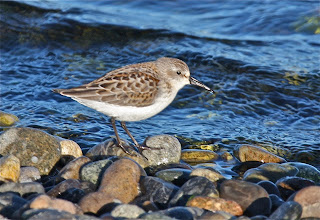 The Keystone Spit / Crockett Lake area of Central Whidbey Island is such a rich place to photograph wild birds, I check there almost every time I drive north. Saturday's weather was a gift -- lovely, warm sunshine and blue sky -- but the wind was whipping and I was not finding much.
The Keystone Spit / Crockett Lake area of Central Whidbey Island is such a rich place to photograph wild birds, I check there almost every time I drive north. Saturday's weather was a gift -- lovely, warm sunshine and blue sky -- but the wind was whipping and I was not finding much.In fact, I was just leaving when my eye caught the flash of wings, a small group of tiny birds flying in formation over the dark blue water of one of the spit's gravel ponds.

After a patient, slow approach on foot to the edge of the pond, I found the birds huddled against the wind atop a drift log. Several were foraging in the shallows for insects and other small creatures.
The birds I had noticed were Western Sandpipers and they had stopped at Keystone Spit for a few hours or a day to eat and rest before resuming their annual migration south.
 It was a good reminder for me that places such as Keystone support a constantly changing population. Where is that flock of Sandpipers today? Nisqually Delta? Oregon Coast? What will I find at Keystone tomorrow? It could be anything. I can count on being surprised.
It was a good reminder for me that places such as Keystone support a constantly changing population. Where is that flock of Sandpipers today? Nisqually Delta? Oregon Coast? What will I find at Keystone tomorrow? It could be anything. I can count on being surprised.For the many birds making their annual, hemispheric migrations, Keystone is a key place to recharge, relatively free of human interference. The wildlife value seems obvious.
 But what of the human value of preserving natural areas such as Keystone, when we could, instead, develop these beautiful settings for upscale homes?
But what of the human value of preserving natural areas such as Keystone, when we could, instead, develop these beautiful settings for upscale homes?For me, it is pretty much the same as for the birds. I would not go to Keystone if it were filled with houses. I would not experience the delights and surprises nature delivers at this wild place every day of the year.
An hour or so at Keystone, watching nature and reflecting on the beauty and diversity of life, recharges me so I can continue on my own journey.
One of my favorite places to go birdwatching!
ReplyDelete